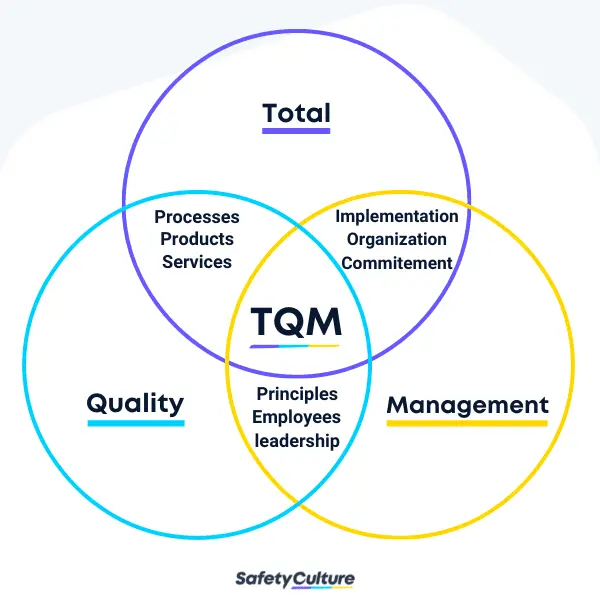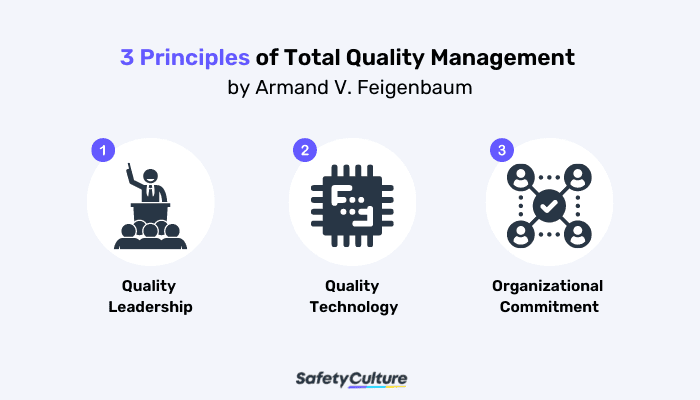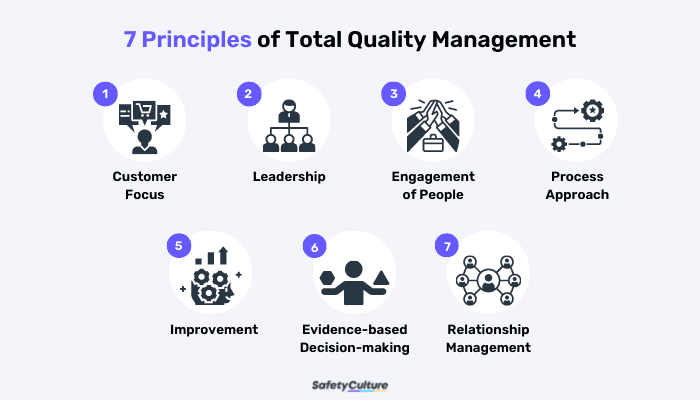What is Total Quality Management?
Total Quality Management (TQM) is an organizational management approach that focuses on producing quality products and services to fulfill customer needs. As a quality management technique, TQM involves all workers to maintain high standards of work across the entire company. Implementing TQM can help improve employee productivity, increase customer satisfaction, and achieve competitive advantage.

Total Quality Management (TGM) Diagram
Importance of TQM
Total Quality Management is often referred to as the antecedent of many quality management methodologies such as Six Sigma and Lean. Some concepts of ISO 9001, the world’s most recognized Quality Management System (QMS) standard, can also be traced back to TQM principles. Total Quality Management is important because it provides an agile framework to implement effective quality and productivity initiatives in every aspect of business operations.
Sources of Total Quality Management Principles
While there has yet to be a single authoritative resource, it is widely accepted that TQM first manifested as early as the mid-1920s, when Walter Shewhart formulated a statistical sampling technique for quality control which was eventually known as Statistical Process Control (SPC).
However, the term “total quality management” only started to be used around the 1980s, where the key to its development is the following principles from distinguished figures in the quality world:
3 Principles of Total Quality Management by Armand V. Feigenbaum

In Total Quality Control, Feigenbaum introduced the concept of Company-wide Quality Control (CWQC) which is agreed upon by some experts as the most direct inspiration for TQM. When searching for 3 total quality management principles, his 3-step approach to improving quality might be one of the first ideas that come to mind:
- Quality Leadership: When enforcing quality efforts, the management should take the lead, and it should be based on sound planning.
- Quality Technology: In the context of the book, this not only means applying statistical methods and other technical or engineering methods, but also adapting to the latest quality management programs in order to satisfy customers in the future.
- Organizational Commitment: All members of the organization, including office staff, engineers, and shop-floor workers have significant roles in improving business quality. Motivating and continuously training the entire workforce shows commitment toward the improvement of product or service quality.
3 Key Principles of Total Quality Management by Joseph M. Juran
Another trio of Total Quality Management principles might actually refer to the 3 critical processes for quality management which is frequently cited as the Juran Trilogy. To put his Quality Control Handbook into better perspective, here are the 3 key principles of his quality management approach:
- Pareto Principle: In the context of quality, this means determining “the vital few and the trivial many,” or the small percentage of root causes in production or service processes that make up the largest effect in terms of defects or cost.
- Management Theory: This includes a paradigm shift from only focusing on the quality of the end product or service to broadly examining the human element of quality management
- Juran Trilogy: The 3 universal processes for managing quality are quality planning (the design phase or building a roadmap), quality control (the application of methods to ensure that processes are in control or unaffected by special causes), and quality improvement (the proactive refinement of processes or making “breakthrough” changes in levels of performance).
14 Principles of Total Quality Management by W. Edwards Deming
With a strong emphasis on organizational change, Deming’s principles for Total Quality Management is more accurately titled “Deming’s 14 Points for the Transformation of Management,” or simply “14 Points for Management.” He first presented these fourteen points in Out of the Crisis:
- Create constancy of purpose for improving products and services.
- Adopt the new philosophy.
- Build quality into the product in the first place.
- Minimize total cost by working with a single supplier.
- Improve constantly and forever every process for planning, production, and service.
- Institute training on the job.
- Adopt and institute leadership.
- Drive out fear.
- Break down barriers between staff areas.
- Eliminate slogans, exhortations, and targets for the workforce asking for zero defects and new levels of productivity.
- Eliminate numerical quotas for the workforce and numerical goals for management. Substitute leadership.
- Remove barriers that rob people of pride of workmanship. The responsibility of supervisors must be changed from sheer numbers to quality.
- Institute a vigorous program of education and self-improvement for everyone.
- Put everybody in the company to work accomplishing the transformation.
7 Principles of Total Quality Management by ISO/TC 176
ISO/TC 176 is the Technical Committee of the International Organization for Standardization (ISO), which develops and maintains quality management standards such as ISO 9000. With the fifth and latest edition which is ISO 9001:2015, the 8 Principles of Quality Management in the 2008 version have been updated to the 7 Quality Management Principles (QMPs).
One main difference is the total removal of the principle “System Approach to Management” which is believed to have been integrated with the principle “Process Approach” as defined below:
- Customer Focus: The primary focus of quality management is to meet customer requirements and to strive to exceed customer expectations. An example of a tool used to integrate customer needs into the overall process is Quality Function Deployment (QFD).
- Leadership: Leaders at all levels establish unity of purpose and direction and create conditions in which people are engaged in achieving the organization’s quality objectives.
- Engagement of People: Competent, empowered and engaged people at all levels throughout the organization are essential to enhance its capability to create and deliver value
- Process Approach: Consistent and predictable results are achieved more effectively and efficiently when activities are understood and managed as interrelated processes that function as a coherent system.
- Improvement: Successful organizations have an ongoing focus on improvement.
- Evidence-based Decision-making: Decisions based on the analysis and evaluation of data and information are more likely to produce desired results.
- Relationship Management: For sustained success, an organization manages its relationships with interested parties, such as suppliers.

Frequently Asked Questions about Total Quality Management
While Total Quality Management has evolved over time—from basic concepts pioneered by top quality gurus to the standards and methods acknowledged by global organizations—its essence of holistically approaching quality management remains. Here are our answers to some of the most frequently asked questions about Total Quality Management:
What are Total Quality Management Examples?
One of the most well-known companies which practiced Total Quality Management is Toyota. The largest automobile manufacturer in the world implemented TQM by looking into how consumers used their products and leveraging on what they learned to improve those products.
Another initiative which made their TQM implementation successful was that top management owned the responsibility for quality, providing support, commitment, and leadership to all human resources and technical processes.
What is TQM Certification?
TQM certification is a business course usually offered by educational institutions to equip people with Total Quality Management principles for practical application in the workplace. Since TQM is an approach to quality management, organizations cannot be TQM-certified, nor is it currently administered by any certifying body.
Therefore, Total Quality Management certification is essentially meant for training individuals in companies to carry out TQM principles using TQM tools.
Does TQM require ISO 9000 Certification?
No, Total Quality Management does not necessarily require ISO certification. However, having a quality management system that meets international standards can help reinforce TQM implementation. Arguably, Total Quality Management as an organizational management approach has been standardized through the requirements specified in ISO 9001.
How is Total Quality Management related to Six Sigma?
TQM is related to Six Sigma in that both methodologies typically involve every part of the organization to bring out the best results for customers. While Total Quality Management highlights the importance of improving quality by optimizing processes, Six Sigma seeks to maintain quality by reducing variance in manufacturing processes and removing causes of defects.
To a certain extent, Six Sigma can be considered as a more refined, scientific approach to actualize Total Quality Management in companies.
What is the Key Difference between Total Quality Management and Lean Manufacturing?
The key difference between Total Quality Management and Lean Manufacturing is that TQM covers general methods to manage quality across the business, while Lean emphasizes on minimizing wastes to streamline quality in production processes. Quality improvement can be achieved as a byproduct of this efficiency in procedures and workflows. Because of this particular similarity, Lean is also commonly associated with Six Sigma, often being mentioned together as “Lean Six Sigma”.
How to Implement Total Quality Management with SafetyCulture
Applying Total Quality Management in the context of your organization can be challenging, especially since its scope seems overwhelmingly vast. With the help of a digital operations management platform or tacking tools such as SafetyCulture (formerly iAuditor), businesses can streamline their TQM implementation. With SafetyCulture, staff members in any aspect of company operations can implement Total Quality Management by:
- Getting everyone on the same page – make your quality planning more tangible by creating and customizing templates that can be deployed across different teams within minutes
- Working towards a common goal – build workflows with ease using enhanced admin controls for scheduling inspections, sharing reports, and more
- Turning issues into actions – work better together through every quality issue and assigned action with traceable timelines that look like a conversation, where team members can chat and add photos
- Leading the way with your data – see the big picture and pinpoint areas for improvement at a glance by reviewing trends across the board or zooming in to view individual responses




